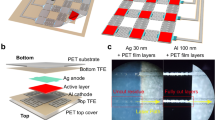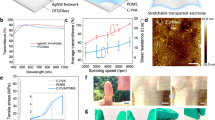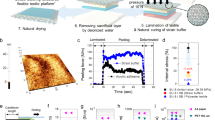Abstract
Textile-compatible photovoltaics play a crucial role as a continuous source of energy in wearable devices. In contrast to other types of energy harvester, they can harvest sufficient electricity (on the order of milliwatts) for wearable devices by utilizing the cloth itself as the platform for photovoltaics. Three features are important for textile-compatible photovoltaics, namely environmental stability, sufficient energy efficiency and mechanical robustness. However, achieving these simultaneously remains difficult because of the low gas barrier properties of ultrathin superstrates and substrates. Here, we report on ultraflexible organic photovoltaics coated on both sides with elastomer that simultaneously realize stretchability and stability in water whilst maintaining a high efficiency of 7.9%. The efficiency of double-side-coated devices decreases only by 5.4% after immersion in water for 120 min. Furthermore, the efficiency of the devices remains at 80% of the initial value even after 52% mechanical compression for 20 cycles with 100 min of water exposure.
This is a preview of subscription content, access via your institution
Access options
Access Nature and 54 other Nature Portfolio journals
Get Nature+, our best-value online-access subscription
$29.99 / 30 days
cancel any time
Subscribe to this journal
Receive 12 digital issues and online access to articles
$119.00 per year
only $9.92 per issue
Buy this article
- Purchase on Springer Link
- Instant access to full article PDF
Prices may be subject to local taxes which are calculated during checkout




Similar content being viewed by others
References
Roundy, S., Wright, P. K. & Rabaey, J. A study of low level vibrations as a power source for wireless sensor nodes. Comput. Commun. 26, 1131–1144 (2003).
Tsai, H. et al. High-efficiency two-dimensional Ruddlesden–Popper perovskite solar cells. Nature 536, 312–316 (2016).
Kaltenbrunner, M. et al. Flexible high power-per-weight perovskite solar cells with chromium oxide–metal contacts for improved stability in air. Nat. Mater. 14, 1032–1039 (2015).
Chung, I., Lee, B., He, J., Chang, R. P. H. & Kanatzidis, M. G. All-solid-state dye-sensitized solar cells with high efficiency. Nature 485, 486–489 (2012).
Mathew, S. et al. Dye-sensitized solar cells with 13% efficiency achieved through the molecular engineering of porphyrin sensitizers. Nat. Chem. 6, 242–247 (2014).
Bernechea, M. et al. Solution-processed solar cells based on environmentally friendly AgBiS2 nanocrystals. Nat. Photonics 10, 521–525 (2016).
Sun, Y. et al. Solution-processed small-molecule solar cells with 6.7% efficiency. Nat. Mater. 11, 44–48 (2011).
Zhang, Q. et al. Small-molecule solar cells with efficiency over 9%. Nat. Photonics 9, 35–41 (2014).
Duan, C., Zhang, K., Zhong, C., Huang, F. & Cao, Y. Recent advances in water/alcohol-soluble π-conjugated materials: new materials and growing applications in solar cells. Chem. Soc. Rev. 42, 9071–104 (2013).
Peet, J., Heeger, A. J. & Bazan, G. C. ‘Plastic’ solar cells: self-assembly of bulk heterojunction nanomaterials by spontaneous phase separation. Acc. Chem. Res. 42, 1700–1708 (2009).
Günes, S., Neugebauer, H. & Sariciftci, N. S. Conjugated polymer-based organic solar cells. Chem. Rev. 107, 1324–1338 (2007).
Liao, S.-H. et al. Single junction inverted polymer solar cell reaching power conversion efficiency 10.31% by employing dual-doped zinc oxide nano-film as cathode interlayer. Sci. Rep. 4, 6813 (2014).
He, Z. et al. Single-junction polymer solar cells with high efficiency and photovoltage. Nat. Photonics 9, 174–179 (2015).
Liu, Y. et al. Aggregation and morphology control enables multiple cases of high-efficiency polymer solar cells. Nat. Commun. 5, 5293 (2014).
Zhao, J. et al. Efficient organic solar cells processed from hydrocarbon solvents. Nat. Energy 1, 15027 (2016).
Manceau, M. et al. Photochemical stability of π-conjugated polymers for polymer solar cells: a rule of thumb. J. Mater. Chem. 21, 4132 (2011).
Holliday, S. et al. High-efficiency and air-stable P3HT-based polymer solar cells with a new non-fullerene acceptor. Nat. Commun. 7, 11585 (2016).
Sun, Y., Seo, J. H., Takacs, C. J., Seifter, J. & Heeger, A. J. Inverted polymer solar cells integrated with a low-temperature-annealed sol-gel-derived ZnO film as an electron transport layer. Adv. Mater. 23, 1679–1683 (2011).
Lipomi, D. J., Tee, B. C. K., Vosgueritchian, M. & Bao, Z. Stretchable organic solar cells. Adv. Mater. 23, 1771–1775 (2011).
Kaltenbrunner, M. et al. Ultrathin and lightweight organic solar cells with high flexibility. Nat. Commun. 3, 770 (2012).
Yokota, T. et al. Ultraflexible organic photonic skin. Sci. Adv. 2, e1501856 (2016).
Dennler, G., Lungenschmied, C., Neugebauer, H., Sariciftci, N. S. & Labouret, A. Flexible, conjugated polymer-fullerene-based bulk-heterojunction solar cells: Basics, encapsulation, and integration. J. Mater. Res. 20, 3224–3233 (2005).
Dennler, G., Scharber, M. C. & Brabec, C. J. Polymer-fullerene bulk-heterojunction solar cells. Adv. Mater. 21, 1323–1338 (2009).
Kim, D.-H. et al. Stretchable and foldable silicon integrated circuits. Science 320, 507–511 (2008).
Vohra, V. et al. Efficient inverted polymer solar cells employing favourable molecular orientation. Nat. Photonics 9, 403–408 (2015).
Nielsen, L. D. Distributed series resistance effects in solar cells. IEEE Trans. Electron Devices 29, 821–827 (1982).
Gevorgyan, S. A. et al. An inter-laboratory stability study of roll-to-roll coated flexible polymer solar modules. Sol. Energy Mater. Sol. Cells 95, 1398–1416 (2011).
Yokota, T. et al. Ultraflexible, large-area, physiological temperature sensors for multipoint measurements. Proc. Natl Acad. Sci. USA 112, 14533–14538 (2015).
Yamada, T. et al. A stretchable carbon nanotube strain sensor for human-motion detection. Nat. Nanotechnol. 6, 296–301 (2011).
Mourad, M. M., Elshakankery, M. H. & Almetwally, A. A. Physical and stretch properties of woven cotton fabrics containing different rates of spandex. J. Am. Sci 8, 567–572 (2012).
Osaka, I. et al. Synthesis, characterization, and transistor and solar cell applications of a naphthobisthiadiazole-based semiconducting polymer. J. Am. Chem. Soc. 134, 3498–3507 (2012).
Tremolet De Villers, B. J. et al. Removal of residual diiodooctane improves photostability of high-performance organic solar cell polymers. Chem. Mater. 28, 876–884 (2016).
Acknowledgements
This work was financially supported by the JST PRESTO (grant number JPMJPR1428) and JST ERATO Bio-Harmonized Electronics Project (grant number JPMJER1105). The authors would like to thank K. Tajima and K. Nakano of CEMS, RIKEN (Japan) and H. Kimura of Waseda University (Japan) for their technical support and helpful discussions. The authors also thank D. D. Ordinario of The University of Tokyo (Japan) for editing and proofreading the manuscript.
Author information
Authors and Affiliations
Contributions
H.J., K.F. and T.S. conceived and designed the research. Y.S., I.O. and K.T. synthesized the polymer material. M.K. and T.Y. fabricated the ultrathin film substrates. H.J., X.X. and S.P. fabricated the OPVs and characterized the devices. H.J., K.F. X.X. and S.P. analysed the data and designed the figures. H.J., K.F., X.X., S.P. and T.S. wrote the manuscript with comments from all of the co-authors. T.S. supervised the project.
Corresponding authors
Ethics declarations
Competing interests
The authors declare no competing financial interests.
Additional information
Publisher’s note: Springer Nature remains neutral with regard to jurisdictional claims in published maps and institutional affiliations.
Electronic supplementary material
Supplementary Information
Supplementary Figures 1–14, Supplementary Tables 1 and 2, Supplementary References
Supplementary Video 1
Washing process using detergent for the freestanding OPVs with a stain on the surface.
Rights and permissions
About this article
Cite this article
Jinno, H., Fukuda, K., Xu, X. et al. Stretchable and waterproof elastomer-coated organic photovoltaics for washable electronic textile applications. Nat Energy 2, 780–785 (2017). https://doi.org/10.1038/s41560-017-0001-3
Received:
Accepted:
Published:
Issue Date:
DOI: https://doi.org/10.1038/s41560-017-0001-3
This article is cited by
-
Pulse irradiation synthesis of metal chalcogenides on flexible substrates for enhanced photothermoelectric performance
Nature Communications (2024)
-
Waterproof and ultraflexible organic photovoltaics with improved interface adhesion
Nature Communications (2024)
-
Ultra-flexible semitransparent organic photovoltaics
npj Flexible Electronics (2023)
-
Highly stretchable polymer semiconductor thin films with multi-modal energy dissipation and high relative stretchability
Nature Communications (2023)
-
Design, fabrication and assembly considerations for electronic systems made of fibre devices
Nature Reviews Materials (2023)



